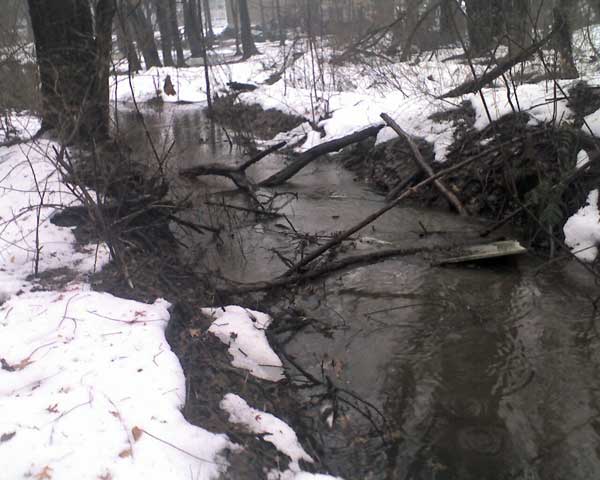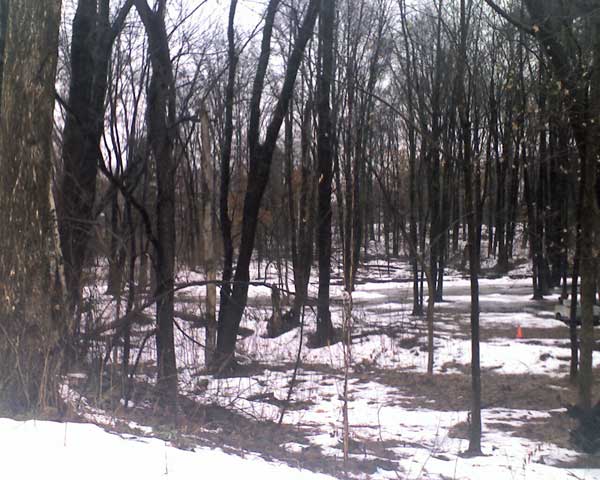All those concerned about the fate of the North Street woods and wetlands are encouraged to attend the following public hearing. Kohl Construction’s proposed 26-unit condo project will encroach within 35 feet of the wetlands. These wetlands, centered around Millyard Brook, are suspected to contain one or more vernal pools. The Conservation Commission plans to evaluate these pools in the spring.
Northampton Conservation Commission
Agenda
Date: Thursday March 13, 2008
Time: 5:30 PM
Place: City Hall Hearing Room (use back door or main Crafts Avenue door) 2nd floor, 210 Main Street, Northampton
For more information: Bruce W. Young, Land Use and Conservation Planner
by****@***********ma.gov
Agenda
5:30 PM
Discussion with Douglas Kohl on Vernal Pool Assessment Protocol on Map 25C, Parcel 12 and 17 located at Northern Avenue and View Avenue…
See also:
Northampton Redoubt: Doug Kohl reduces “footprint” of subdivision proposal due to the discovery of vernal pools in the North Street area wetlands (9/13/07)
Doug concedes that there are likely at least two previously unmarked vernal pools on the site that are located in the wetlands area as pictured far below. As a consequence of this discovery he suggested that the total number of units proposed would be reduced from 31 to 27. Another housing unit has been deleted on Northern Avenue as a proposed triplex will become a duplex reducing further the total number of units to 26. This would lessen the amount of impervious surface area required and he added that there would likely be fewer than five detention ponds established as well. If additional vernal pools are discovered in the spring the proposal could change further…
vernal pool #1
vernal pool #2
Conservation Commission Votes to Delay Vernal Pool Delineation on Kohl Property to Spring 2008 (8/23/07)In a significant victory for NSNA, Northampton’s Conservation Commission voted tonight to delay until spring its review of vernal pool delineation on Kohl Construction’s proposed condo site behind North Street. In its original Wetlands Application (PDF) filed several weeks ago with the city, Kohl asserted there were no existing or potential vernal pools on the site:

After further inspections of the site conducted by NSNA’s wetlands expert (Alec MacLeod, report) and Kohl’s (Molly Hale and Chuck Dauchy), Kohl Construction now concedes that there are probably one or more vernal pools on the site…
Report on Kohl’s Property by Alec MacLeod, Environmental Scientist: Indications of Vernal Pool Habitat (8/22/07)
This site is particularly difficult to delineate, as the differences between areas meeting the technical definitions of hydrophylic plant communities and hydric soils are very slight over much of the site…
…given the presence of vernal pool habitat, the buffer zone becomes quite important, since such vernal pool obligate species as Wood Frogs and Spotted Salamanders live in uplands during most of the year. It has been the case that the Northampton Conservation Commission has identified a no-build setback policy. The Commission should assure that as much buffer zone is protected as is reasonably possible…
Northampton’s Flood and Natural Hazard Mitigation Plan: Floyd Flood Damage Reported Behind View Avenue; Avoid Building on Filled Wetlands (8/24/07)
On September 2, 2004, the Northampton City Council approved a Flood and Natural Hazard Mitigation Plan (PDF). The Project Manager for developing this plan was Gloria McPherson, Conservation and Land Use Planner. Ms. McPherson now works for Kohl Construction. Here are key highlights from the plan with respect to NSNA’s objectives, followed by an expanded overview…
Some areas of Northampton contain critical wildlife habitat, including 29 state-certified vernal pools that support a variety of rare and endangered species. There are also 20 identified potential vernal pools.
While areas containing significant wildlife habitat are not considered hazardous in the traditional sense of potential impacts to persons and property, when viewed in the larger context, it is land that is inappropriate to develop because of potentially long-ranging and significant impacts to the biological community and, in turn, to humans who are an integral part of it… (p.24)
Chilmark Wetlands Protection Bylaws: Disturbed and Filled Wetlands Merit Protection (9/3/07)
Isolated land subject to flooding and Vernal Pools provide important breeding habitat for amphibians and some rare plants. Vernal Pools hold water for at least two continuous months, but contain no fish predators.
Metro Portland: “Nature in Neighborhoods” (11/11/07)
It appears to us that that the woodland/wetland area behind North Street, proposed for development by Kohl Construction, is exactly the kind of ecology that the Portland model ordinance is trying to preserve. Even if classified as having “High Urban development value”, the forested area within 100 feet of the wetland would appear to qualify as a Class I Riparian zone and a Moderate Habitat Conservation Area. This in turn, would appear to cap the allowable disturbance of this area to 15% of the site, unless it was dedicated to single-family homes.
It’s unfortunate that Northampton’s new Wetlands Ordinance encourages development as close as 10 feet to wetlands in our more built-up areas. There is much to be learned from the experience of the West, which has witnessed the effects of rapid growth in formerly green areas.
Massachusetts Audubon: The Value of Floodplain Forests (2/13/08)
Floodplain forest…is a disappearing ecological treasure… [Their] cyclical flooding regime continually refertilizes the floodplain and nourishes the well-adapted trees and understory…
“Apart from preserving ecological habitat, a wildlife corridor, and a greenway,” says Blunt, “the DCR has some very practical reasons for restoring these [floodplain forests along the Connecticut River].” The broad areas of the floodplain forest are natural water-storage areas. During significant floods—and such events can occur any time of the year—water overspreads the flat wetlands and loses velocity. The trees act as filter strips, holding back sediments and reducing the extent of downstream damage…
“Putting housing [in the Belmont Uplands] would be totally un-smart growth,” says FAR’s Ellen Mass. “Basically, the people living here would be surrounded by a mosquito marsh.”
Photo Essay: Millyard Brook Swells with Water in Winter (1/12/08)
On January 11, a mild and rainy day, Millyard Brook is clearly not dry, but helping a large volume of water flow safely through the neighborhood. Adding impervious surface near streams like these can increase the speed and volume of runoff that flows into them and make them more flood-prone. In addition, the pollution from developed areas (e.g. salts, oils, herbicides) can harm the vegetation. As the City of Northampton acknowledges, “Problems with nutrient runoff, erosion, siltation, loss of groundwater recharge, poor water quality, vegetation change and harm to wildlife habitat are greatly exacerbated by activities within 100 feet of wetlands…”


These areas of pooling water near the brook are suspected to contain one or more vernal pools…
Paved Surfaces, Salt and Water Bodies: A Bad Mix (2/18/08)
Connecticut River Watershed Action Plan: Remove impervious surfaces within 50 feet of streams (9/8/07)